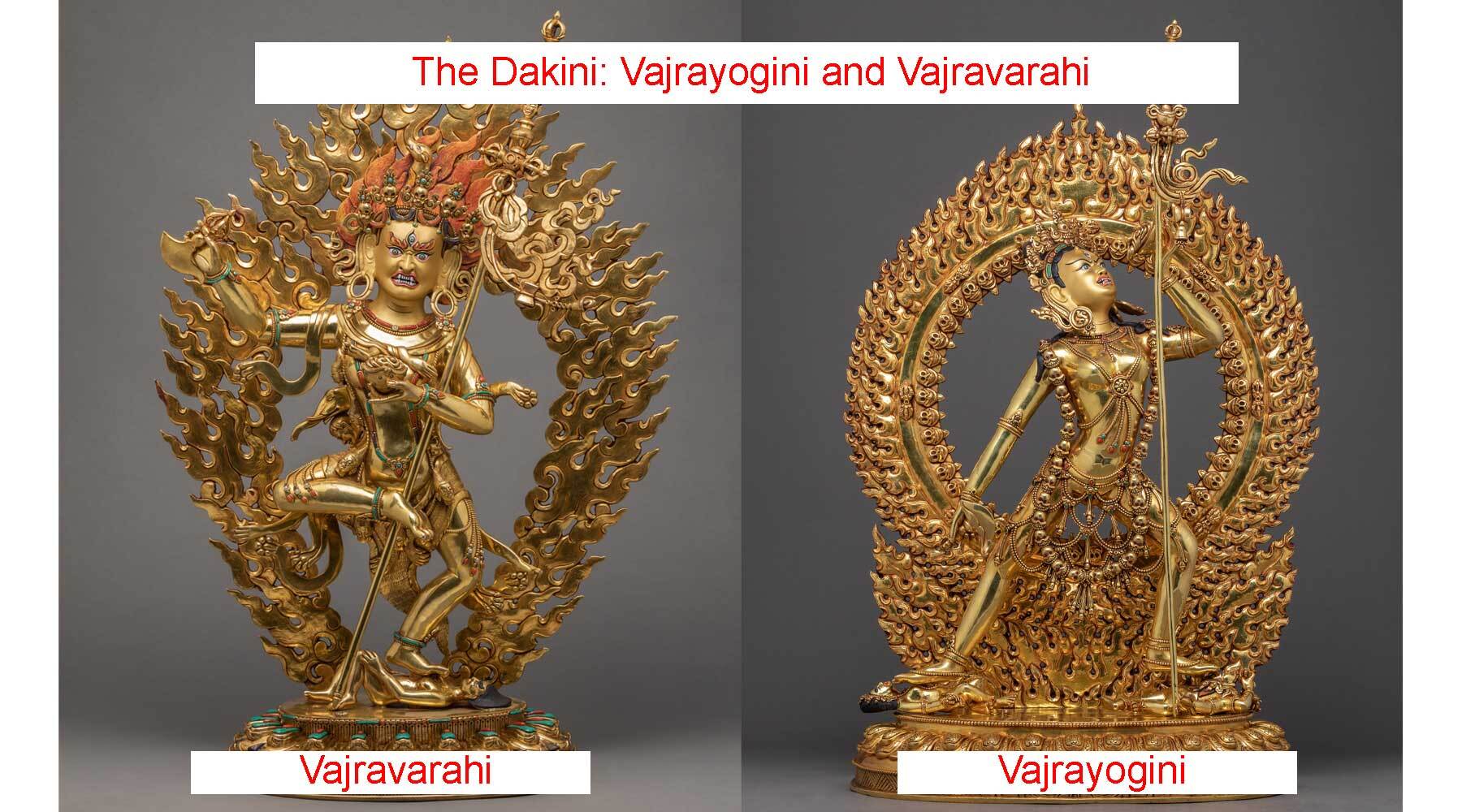The Two Dakini: Vajrayogini and Vajravarahi
The enlightened goddess known as Vajrayogini is most closely related to Vajrayana Buddhism and is thought to be the embodiment of all Buddhas' wisdom. Vajra is the Sanskrit word for "diamond" or "thunderbolt," and yogini is the term for a female yoga practitioner.
She serves as a metaphor for the route to becoming a female Buddha. She is regarded as the perfect representative of Vajrayana Buddhism as she guides practitioners down the road that leads to enlightened goodness.
As a Buddha, Vajrayogini has three different manifestations or bodies. Her ultimate "body" (dharma-kaya), which is carved of just pure light and understanding, has no shape. She also manifests in subtle "bliss bodies" (sambhogakaya), the heavenly embodiments she assumes in her role as a goddess, where she achieves enlightenment, disperse knowledge, and inspires others. The third is her appearance among people in the physical world, known as her "emanation body" (Nirmanakaya).
She is a Dakini who dispels one's ego and delusion by embodying grace and destruction. The multiple components of her body serve as a reflection of the foundation we must give up, the path we must take spiritually, and the result we must get in order to become fully enlightened. She appears above terrestrial deities, for example, as a symbol of her victory over attachment, hatred, and ignorance. Her body represents the wisdom of all Buddhas in its unaltered condition, and her five decorations stand in for the other five perfections shared by all Buddhas. Her main objective is to lead every sentient creature to Pure Dakini Land. Vajrayogini is the embodiment of "great passion" (maharaga), a transcendent desire free from self-interest and illusion. She makes a lot of effort to undermine her ego and promote the well-being of everyone else.
Vajravarahi and What She Represents
Vajravarahi is called "Dorje Phagmo" in Tibetan, while "Indestructible (Vajra) Sow (Varahi)" in Sanskrit. She is the wrathful persona of Vajrayogini.
As a renowned Yidam goddess and the companion of Chakrasamvara, her practice is essential in the Tibetan Kagyu traditions. Her identifying feature is the sow's head, which frequently occurs over or behind her right ear.
Iconographic Differences and Similarities Between The Vajrayogini and Vajravarahi:
The Major Similarities in the Statue Depiction:
Both are shown with bodies that are ruby red and radiantly glowing.
1. They hold the same attribute in both hands as they stand in the middle of the raging wisdom fire which engulfs the statue from the backside.
2. Curved Knife in right-hand and Skull cup in the left
3. On their left shoulder, they are holding a khatvanga that represents their spiritual partner and is capped with a Vajra.
4. Both of them are adorned with bone jewelry, including necklaces, bracelets, armlets, anklets, and a skull crown.
5. Vajravarahi, on the other hand, is pictured as being dressed with a garland of 50 freshly severed heads, and Vajrayogini wears a garland of 50 skulls.
Vajrayogini As Depicted In Buddhist Statues:
Vajrayogini is frequently shown with a blood-red body and a wrathful appearance. Her crimson body is a representation of the life force, the blood of birth, and the roaring fire of spiritual change inside her. Her solitary face stands for her understanding that nothingness is the universal denominator in all things. Her two arms stand in for her understanding of both worlds, while her three eyes indicate her capacity to observe everything in the past, present, and future.
She has a skullcup in her right hand, and her right leg is extended while her left leg is slightly bowed. She carries a curved knife as a representation of her capacity to cut through the range of challenges and illusions that all living things, including her followers, experience.
She consumes the blood from the skull cup in her right hand, signifying the unadulterated joy. Cremation sites make up her entire surroundings. It contrasts the rich inner world with its perspective of reality without falsifying fantasy.

Click Here To View Our Vajrayogini Statue Collection.
The Vajravarahi Mantra
oṃ va jra yo gi nī hūṃ pha ṭ svā hā
Vajravarahi As Depicted In Buddhist Statues:
Traditionally, Vajravarahi is shown with a reddish-colored body and three penetrating eyes that have young, passionate, and occasionally malevolent expressions.
She is depicted with two hands, the same features as Vajrayogini, a trident in her left hand, a skull cup filled with waves of ambrosia overflowing with blood in her right, and a dagger in her right.
She holds her left leg up in the air like she's dancing (diamond posture). To symbolize the destruction of illusions and the victory over the ego, she stepped over a body. She frequently appears with a flame of antiquated knowledge. Her tawny hair likewise shoots up in a fire-like motion. She is often seen wearing a sow's head as an ornament on the side of her own body, and in other instances, she even sports one herself. Buddhism uses the pig as a representation of ignorance. This represents the triumph of knowledge over ignorance. 
Click Here To View Our Vajravarahi Statue Collection.
The Three Consorts of Vajravarahi
Vajravarahi is often perceived as being in union with different enlightened figures. While Heruka Chakrasamvara is her primary consort, Hayagriva and Avalokiteshvara are her other two consorts.
Vajravarahi, in union with Heruka Chakrasamvara [Tib: Khrolo Demchog], is depicted as Sahaja Chakrasamvara.
Hayagriva is a wrathful emanation of Avalokiteshvara. Vajravarahi and Hayagriva are in the union in a form termed Hayagriva Vajravarahi Chintamani [Tib: Tapag Yishin Norbu].
Vajravarahi is the spiritual partner of Jinasagara [Tib: Gyalwa Gyatso], a form of Avalokiteshvara.
She is revered as the Dakini of her primary teachers, such as Marpa, Milarepa, and Gampopa.
Vajravarahi is a Dakini and spiritual force that is said to transform the Five Negative Afflictions, which stand for five impediments that prevent Buddhists from achieving enlightenment through obscuring the actual essence of existence. The Five Afflictions are
- greed
- Hatred
- Delusion
- Envy
- Pride




